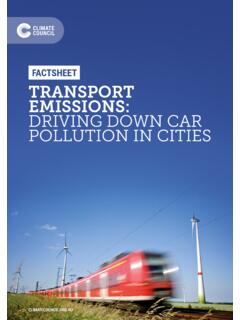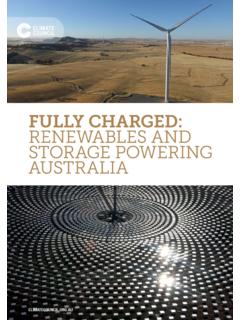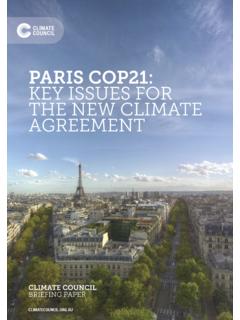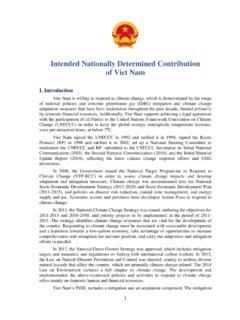Transcription of AUSTRALIA’S RISING GREENHOUSE GAS EMISSIONS
1 AUSTRALIA'S RISING . GREENHOUSE GAS. EMISSIONS . Thank you for supporting the Climate Council. The Climate Council is an independent, crowd-funded organisation providing quality information on climate change to the Australian public. Published by the Climate Council of Australia Limited ISBN: 978-1-925573-59-6 (print). 978-1-925573-58-9 (digital). Climate Council of Australia Ltd 2018. This work is copyright the Climate Council of Australia Ltd. All material contained in this work is copyright the Climate Council of Australia Ltd except where a third party source is indicated. Climate Council of Australia Ltd copyright material is licensed under the Creative Commons Attribution Australia License. To view a copy of this license visit You are free to copy, communicate and adapt the Climate Council of Australia Ltd copyright material so long as you attribute the Climate Council of Australia Ltd and the authors in the following manner: Working paper: Australia's RISING GREENHOUSE gas EMISSIONS .
2 Authors: Greg Bourne, Andrew Stock, Will Steffen, Petra Stock and Louis Brailsford. We would like to thank Anna Malos (ClimateWorks) for her thorough review.. Cover image: Loy Yang 2 by Flickr user Greenstone Girl licensed under CC BY-NC This report is printed on 100% recycled paper. CLIMATE COUNCIL i Contents Key ii 1. Introduction ..1. 2. Australia's RISING 6. 3. Assessing Australia's 2030 EMISSIONS reduction 9. 4. Sector Profiles:.. 12. Electricity 12. Transport 15. Stationary Energy 18. Agriculture 21. Fugitive EMISSIONS 24. Industrial Processes 26. Waste 28. 5. The electricity sector can and should do 30. 32. Image 34. Authors: Greg Bourne Professor Andrew Stock Professor Will Steffen Climate Councillor Climate Councillor Climate Councillor Petra Stock Louis Brailsford Senior Energy and Climate Researcher Solutions Analyst ii WORKING PAPER: AUSTRALIA'S RISING GREENHOUSE GAS EMISSIONS .
3 Key Findings 1 2. Australia's EMISSIONS are Australia's EMISSIONS A more appropriate target for RISING and projected to reduction target is woefully Australia in line with the science continue increasing without inadequate to protect would be a 45-65% EMISSIONS credible and comprehensive Australians from intensifying reduction target by 2030, as climate and energy policy. climate change. recommended by the Climate Change Authority and zero net Australia's GREENHOUSE gas Australia's 26-28% EMISSIONS EMISSIONS well before 2050. EMISSIONS have increased for reduction target for 2030 on a the past three years, reaching 2005 baseline is not adequate MtCO2e in the year to to meet the Paris Climate December 2017. Agreement targets.
4 Australia's GREENHOUSE gas Australia's share of the emission levels are very close remaining global carbon to all-time highs (excluding budget is about 5,500 Mt CO2e. land use EMISSIONS ). If Australia's EMISSIONS Eight of Australia's major sectors continue at current rates we are responsible for Australia's have only 10 years remaining RISING EMISSIONS . These sectors before we will completely are electricity, transport, exhaust our carbon budget stationary energy, agriculture, before 2030. fugitive EMISSIONS , industrial processes, waste and land use. If other countries were to adopt climate policies similar to The electricity sector is the Australia's then global average biggest polluter accounting temperature rise could reach for 33% of our EMISSIONS .
5 Over 3 C and up to 4 C. A four degree world would present serious challenges for human survival, placing billions of lives at risk. KEY FINDINGS iii 3. Applying a pro-rata EMISSIONS 4. Australia is currently not 5. The electricity sector can reduction target of 26-28% by even on track to meet its and should do more to 2030 to each sector is not the current inadequate EMISSIONS reduce EMISSIONS . most cost-effective way reduction target for 2030. to reduce EMISSIONS . Cost-effective technologies The electricity sector would be such as energy efficiency, The Federal Government's required to reduce cumulative renewable energy and storage National Energy Guarantee EMISSIONS by only 8% compared are readily available and can proposes to lock in a 26% to business as usual from 2018 be rapidly deployed to reduce EMISSIONS reduction target and 2030 in order to achieve a electricity EMISSIONS , creating for the electricity sector.
6 This pro rata reduction. the time for policies in other approach implies other sectors sectors to be established and would also be expected to Other than waste, all sectors will implemented. reduce their EMISSIONS by 26% be required to proportionally by 2030 (on 2005 levels). reduce EMISSIONS by far more Several studies have consistently than the electricity sector found that there are no technical Applying a pro-rata reduction (compared to business as usual). barriers to Australia achieving target to each sector would secure, reliable power from mean significant new policies Transport EMISSIONS and a very high proportion of and EMISSIONS reductions fugitive EMISSIONS would need renewable electricity. are required for every sector to be cut by around a third.
7 Between now and 2030. In contrast, there are far fewer Stationary energy (excluding opportunities to rapidly reduce The electricity sector is better electricity) EMISSIONS would EMISSIONS from other sectors, placed to reduce EMISSIONS at need to be cut by 31%. especially agriculture and lower cost than other sectors, fugitive EMISSIONS . such as agriculture and fugitive Agriculture EMISSIONS would EMISSIONS . Reducing EMISSIONS need to be reduced by 23%. in these sectors will potentially and EMISSIONS from industrial be very costly and challenging, processes, which includes whereas options to reduce chemical and metal production, electricity sector EMISSIONS by 22%. Waste EMISSIONS would are readily available and cost only need to be cut by 5%.
8 Effective ( renewable energy and storage technologies). 1 WORKING PAPER: AUSTRALIA'S RISING GREENHOUSE GAS EMISSIONS . 1. Introduction In 2017, Australia's GREENHOUSE gas Australia's 2030 EMISSIONS reduction target EMISSIONS increased for the third of 26-28% falls significantly short of what consecutive year, approaching is required to effectively tackle climate all-time highs (excluding the land change. The Climate Change Authority use - LULUCF - sector) (Australian recommended a 45-65% EMISSIONS Government 2018). In order to limit reduction target for 2030 below 2005. global temperature rise and tackle levels, based on scientific evidence, what increasing extreme weather fuelled comparable countries are doing and what by climate change, the Federal is in the best interests of Australia (Climate Government has committed to the Change Authority 2015).
9 Recent analysis near-universally agreed Paris Climate implies that Australia will not meet its Agreement. As part of this agreement, woefully inadequate 26-28% EMISSIONS the Federal Government has set reduction target (UNEP 2017). in place an initial target to reduce Australia's GREENHOUSE gas EMISSIONS If all other countries were to have similar by 26-28% below 2005 levels by 2030 climate policies to Australia's, then global (Department of the Environment and average temperature could reach over 3 C. Energy 2015). and up to 4 C above pre-industrial levels (Climate Action Tracker 2018). A four degree world would make it very difficult for human civilisation to cope, putting billions of lives in danger (New et al. 2011).
10 Australia is already experiencing the impacts of climate change. The world has just experienced the hottest five- year period (2013-2017) ever recorded. This record is part of a sharp, long-term upswing in global temperatures, with 17 of the 18 hottest years on record all occurring in this century. Increasing global temperatures, driven primarily by higher carbon dioxide levels from the burning of fossil fuels, is exacerbating extreme weather events around the globe and in Australia. Heatwaves are now hotter, lasting longer and occurring more often. RISING ocean temperatures are triggering coral bleaching events on the Great Barrier Reef. INTRODUCTION 2. Australia's GREENHOUSE gas EMISSIONS have increased for a third consecutive year.










